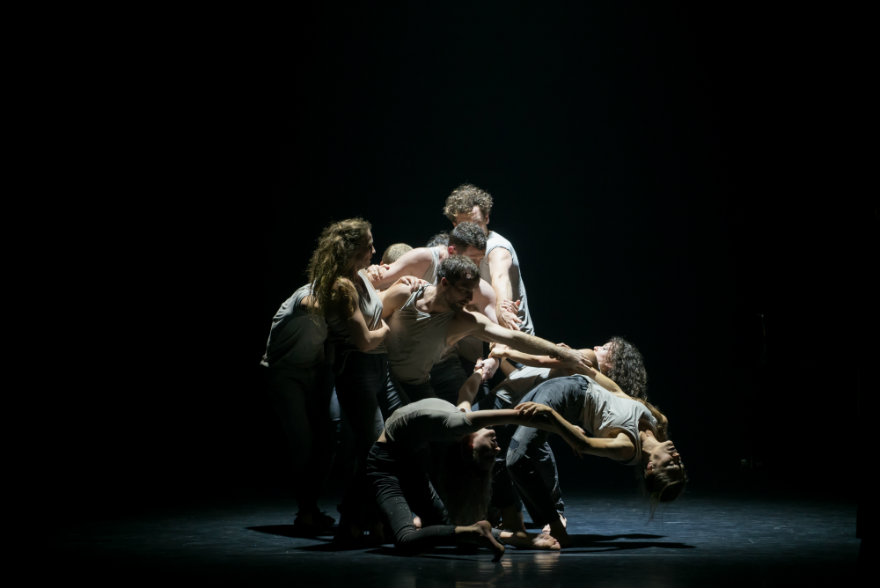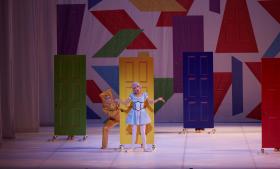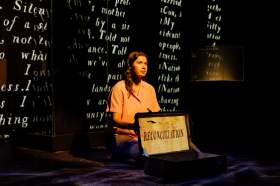I came here from a country that is ablaze. As a result of human-caused climate change (and the science on this is definitive) my home Australia is experiencing the worst bushfires in its history.
As I departed through the haze, I reflected on how these fires have created a palpable sense of disquiet – they have they have roused our nation from its apathetic slumber. It is not clear whether our political climate will change as much as our environmental climate demands it must, but the fires have broken the tethers of our inertia.
I also reflected on what an extraordinarily beautiful set of sunsets these fires have caused and how we’re lucky (an obscene usage of the word) to have an aesthetically impactful catastrophe. Photogenic, it found a home on the front pages of newspapers and media feeds around the world. Its formidable force and mythic beauty catapulted it past other, equally worthy catastrophes. It roused celebrities who managed to virtue signal even as they missed the point. Australia is rich – we don’t need charity. We need deep, lasting, effective climate policy to stop our country burning. As does the rest of the world.
The political impact of the fires is not separate from their aesthetic charge – they matter because they are powerful, dramatic, visually striking events. As our legacy festivals and heritage companies present Nutcrackers and the latest novelty touring productions, an authentic, fierce promethean drama is roaring throughout the country.
***
Greta Thunberg said that this is no time for grey thinking. Only black and white will do. We need certainty and action. When it comes to stopping our Pacific neighbours being drowned, splitting the infinitives of policy nuance is really just criminal neglect and future theft.
But the great post-Holocaust poet Paul Celan implored us to ‘leave yes and no unsplit’ and this I believe too. Great art isn’t about pre-digested positions and simple certainties. The stage, the art gallery and the concert hall must be safe places to do complex cultural thinking; the sort that invigorates, excoriates and impassions. Without grey thinking you don’t have Shakespeare or Homer or Jane Austen. The Greeks exist only in the unsplit space between the human and the divine. When Oedipus discovers that he is a both protagonist and antagonist, villain and victim we have culture, debate, humanity. But we don’t have straightforward answers or swift actions.
These opposites are unreconcilable. Trauma and beauty. Astonishment and improbability. Strong action and nuanced reflection. Unless we add culture. Because culture enables us to communicate across borders, to meet others, to share stories, to forge new languages and win fresh understandings.
The word sonder is a relatively new noun for ‘the realisation that each random passerby is living a life as vivid and complex as one’s own’. What a magnificent concept. And art is, at its core, a sondering.
That is what the fires have done for us. They have put us in a collective state of sonder. Suddenly we are unbound by our own reality – we are empathetically receptive to the other.
Empathy is a creative act. It requires we imagine ourselves in someone else’s reality. This gift of empathy might be art’s highest purpose and its most necessary and urgent offering.
This gift of empathy might be art’s highest purpose and its most necessary and urgent offering.I came to the theatre as a calling. I am almost uniquely unqualified for it. I can’t dance, act or sing. But I was bewitched by a moment. As the lights go down, just before the performance starts, there is a bolt of electricity that runs through the audience. A moment of magic when whole worlds seem possible.
Soon after, performers generally start taking and gesticulating and I never really got it. But that moment had been there. So I asked, ‘What would it take to keep that electric moment alive?’ I studied at our national institute but found plays ultimately weren’t my medium. Via opera and events, I wended my way, 20 years ago, circuitously to the circus and I have been here ever since.
Jump forward to 2012. We have created a show, How Like an Angel for the cultural Olympiad. It featured a team of our artists working with Gramophone award-winning vocal ensemble I Fagiolini, under my direction in cathedrals around the UK. And being promenade-style, I spent the first few shows roaming around, checking on audience flows. On one night I decided just to watch. There was a simple sequence in the show, a transition really, where someone leant and met another body and the two swayed back in the other direction and a third joined; a kind of human Newton’s Cradle formed as the pattern continued. I stood, looking at this average piece of stagecraft when suddenly I horripilated (that is, the hairs literally stood up on the back of my neck). In the nave of this 11th century cathedral, accompanied by the heavenly sounds of Victoria’s Alma Redemptoris Mater, the whole audience were swaying as one, subconsciously, in time with the artists. There was electricity in the room. We sondered.
Time and again I had the privilege of sitting in the audience while Circa acrobats delivered a searing performance, visceral, raw, a vital work of extreme physically and emotion. And across the world – from Paris to Guadalajara, from Bathurst to Edinburgh, there is a collective intake of breath as the final curtain falls at the end of the Circa performance. A moment of release. Followed by a roar of deep, heartfelt appreciation. True connection.
In complicated times this authentic and powerful moment is a reminder of what we share and how easily we might lose it.
****
Our journey wasn’t straightforward but journeys seldom are.
In 1999 I joined Rock ’n’ Roll Circus. It was a pioneering circus company in need of re-invention and they appointed me as their first artistic director. We lost funding and everyone hated our work. For six years we got atrocious reviews. One highlight was the review of someone else’s show that said ‘It’s great to see some work that doesn’t seem intent on sucking the joy out of circus like our local company’. Suck the joy became a rallying cry. Suck, the joy.
But there was something alive in the work. We had great people, a space and ideas.
We became Circa and eventually we made a show people actually liked. At this stage our resources had dwindled to me and three acrobats. Now, 15 years later, we have a full time, year-round ensemble of 23 artists. We have just been invited to join the operas and ballets of the Australian arts scene as a Major Performing Arts company. We’ve performed around 400 shows across 15 countries and since that first show our work has been seen by over a million people. We have programmed the Commonwealth Games arts festival, we run touring for the state of Queensland, we deliver workshops and engagement programs to over 10,000 people a year. Our graduates and alumni have created a wave of contemporary circus that has been celebrated at festivals and venues around the world.
And we know this is only the start.
‘Wisdom,’ said Socrates, ‘begins in wonder’. Like all circuses we can stack people three or four people high, we can hang precariously, leap daringly, bend unrealistically and balance improbably. But our special superpower is this: we are intensely curious. The psychologist Adam Grant talks about the proving versus the improving mindset. Circa is an improving mindset. We love to pull things apart and figure out how to do them better. Our artistic mission is to ask harder questions. We like to treat our art like it’s a business and our business like it’s an art – looking for new ways, opportunities and ideas. We recently rewrote our corporate purpose – we now exist to ask ‘What is possible in circus?’ It is the question mark that keeps us honest, it is the question mark that drives us to find existing borders and cross them or redraw them or sometimes just ignore them.

Circa’s new work, Sacre. Photo by David Kelly.
Contemporary circus is seldom the easiest of options. But it is a vital and valid one. And here’s why.
What is a border? It is a ceasefire line from the past. And it’s the same with the arts. Opera and ballet, classical music and rock, traditional and contemporary dance are all divided by lines that do not exist.
And it’s time to erase them.
We need new forms for new realities.
We are on fire.
Our planet is teetering. Rising seas. Rising fundamentalisms. Rising inequalities. The decay of civic society. The transformation of infinite games to finite ones where compromise and nuance are replaced by desire for victory and the need for certainty.
Our response needs to be both ‘no time for grey’ and ‘leave yes and no unsplit’.
It’s time to unleash the force of what art can do, as a force for good. For this we have to make it reach new audiences, inspire fresh voices and engage diverse participants.
‘Tradition,’ said Gustav Mahler, ‘is not the worship of ashes, but the preservation of fire.’
To preserve the fire of art, it needs to leap its current containment lines. Borders are the past, they are the ashes. The future is simply this – great work that speaks directly to humans. Donald Hall said a poem is a person on the inside talking to a person on the inside.
All art aspires to the condition of poetry.
Circus has taught me that we can collaborate widely and connect deeply. And when we do, borders dissolve.
In 2019 we were the first circus company ever to perform at the Salle Pierre Boulez at the Paris Philamonie and we were the first circus company to perform in the Palau de la Música in Barcelona. We have performed shows in cemeteries and cathedrals. We have collaborated with orchestras, opera companies, string quartets and visual artists. And we will continue to relentlessly ask: what is possible in circus?
To preserve the fire of art, it needs to leap its current containment lines.Ultimately if we want a different future we have to be able to imagine it.
In the late 1960s, just a few years before a human set foot on the moon, a US poll asked respondents to rank government programs according to their importance. The Apollo space program came in second to last, outranked only by the perceived unimportance of federal support for artists and the arts. Yet what do we remember of the era? The space program and the extraordinary effusion of new, vibrant forms of artistic expression.
Our imagination is bordered by what it knows. Artists work beyond those boundaries. And if they are right, they will change the world.
In circus, we are lucky to work in the badlands beyond genre where we rely on neither convention nor comprehension; our work almost always sits outside of all the sides. As our DNA is ancestrally connected to the world of entertainment, we are born with a single commandment tattooed inside our eyelids: ‘Thou shalt not bore’. As the genre of circus has deepened and widened to become a related family spanning from commercially driven tradition forms to highly adventurous contemporary art, we are in a privileged position. We can find new audiences, breathe new life into stuttering forms and reinvigorate old ideas.
****
Indulge me for a moment. Look at someone in the room with us. Anyone. Picture the longest thing in their body. Try to imagine its length. Line it up against something you know. Is it as long as a door, a bathtub, a room? How long is the longest thing in their body?
In fact, in all of us, it is our DNA. If we take each of the tiny packets of it in our cells and unfurl them, lay it all end to end, each of us would not reach the ceiling but rather we would span around the solar system, twice. That is how large we are.
As Walt Whitman said, we are large, we contain multitudes. We span the solar system twice, each of us. Imagine the thicket of connections we have. The possible entanglements, the discoveries, the journeys.
The world is vast and mysterious. We as artists are noble guides who create the opportunity to imagine this and other worlds; we create these and other futures.
The life of an artist is one lived with intensity and belief. It is difficult, fraught with insecurities and challenges. Not the least among these is the constant need to cross borders that do not yet exist with passports that have yet to be written.
This is vital, now as never before.
The word courage is derived from the same Latin as the French word for heart. I wish everyone in this room the strength and heart to venture boldly, with courage.
Thank you.
This is an edited version of a provocation delivered by Yaron Lifschitz at the 2020 ISPA Congress in New York on Thursday 16 January.





